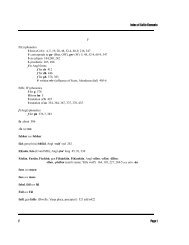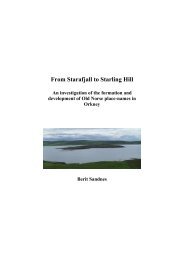May Williamson: The Non-Celtic Place-Names of the Scottish Border ...
May Williamson: The Non-Celtic Place-Names of the Scottish Border ...
May Williamson: The Non-Celtic Place-Names of the Scottish Border ...
Create successful ePaper yourself
Turn your PDF publications into a flip-book with our unique Google optimized e-Paper software.
i<br />
/i/<br />
PREFACE<br />
This <strong>the</strong>sis has been produced under <strong>the</strong> conditions <strong>of</strong> <strong>the</strong> Gatty (Florence Emily and Charles<br />
Tindal) Memorial Scholarship, <strong>the</strong> holder <strong>of</strong> which “must pursue advanced study or research<br />
in <strong>Scottish</strong> Language and Literature with special reference to dialects on both sides <strong>of</strong> <strong>the</strong><br />
border and to such border antiquities and music as bear on <strong>the</strong> subject”.<br />
In order to satisfy <strong>the</strong>se requirements as far as possible, ra<strong>the</strong>r more attention has been given<br />
to historical and dialectal notes than is usual or necessary in place-name studies.<br />
<strong>The</strong> following work is intended as a survey <strong>of</strong> <strong>the</strong> Anglo-Saxon and Scandinavian place-name<br />
material in <strong>the</strong> <strong>Border</strong> Counties. I have tried to demonstrate what types <strong>of</strong> names occur, where<br />
<strong>the</strong>y are situated, and roughly to what period <strong>the</strong>y belong. Thus it has been more convenient<br />
to group <strong>the</strong> names under <strong>the</strong>ir endings than to arrange <strong>the</strong>m by parishes in <strong>the</strong> manner <strong>of</strong> <strong>the</strong><br />
English <strong>Place</strong>-Name Society’s (EPNS) volumes.<br />
It is almost impossible to date <strong>Scottish</strong> place-names with any certainty since spellings for <strong>the</strong><br />
majority are not found before <strong>the</strong> 13 th century, but /ii/ generally <strong>the</strong>y may be classified under<br />
three headings:-<br />
(a)<br />
(b)<br />
(c)<br />
Old English<br />
Middle English<br />
Scandinavian, and Middle English <strong>of</strong> Scandinavian origin<br />
Between <strong>the</strong> first two classes <strong>the</strong>re must be a good deal <strong>of</strong> overlapping. It is known that names<br />
in -ing, -ingahām, -ingtūn and -hām probably ceased to be formed after <strong>the</strong> Old English (OE)<br />
period, but many <strong>of</strong> <strong>the</strong> o<strong>the</strong>r habitational endings which in England belong to this time must<br />
have continued to be formed at a much later date in <strong>the</strong> North. Similarly many <strong>of</strong> <strong>the</strong> names<br />
classified as Middle English (ME) may belong to <strong>the</strong> OE period.<br />
It has been my practice to count as an ending <strong>the</strong> second element <strong>of</strong> each name if a habitative<br />
or topographical term. Thus Torwoodlee is discussed under -wood and Capehope Burn under<br />
-hope. Only <strong>the</strong> main, or original, parts <strong>of</strong> names are <strong>of</strong> importance in a survey <strong>of</strong> this kind,<br />
and so where groups occur such as Caverton, Caverton Mains, Caverton Hillhead, Caverton<br />
Mill, I have dealt only with <strong>the</strong> basic name, Caverton.<br />
<strong>Names</strong> which do not appear in <strong>the</strong> 1-inch Ordnance Survey maps, but which are found in<br />
sources before 1600, have been used for purposes <strong>of</strong> illustration and comparison. In most<br />
cases I have not consulted <strong>the</strong> /iii/ 6-inch maps in attempts to locate <strong>the</strong>se or o<strong>the</strong>r minor<br />
names.<br />
<strong>The</strong> phonetic symbols used in <strong>the</strong> transcription <strong>of</strong> place-name pronunciations are those<br />
normally employed by <strong>the</strong> EPNS.




